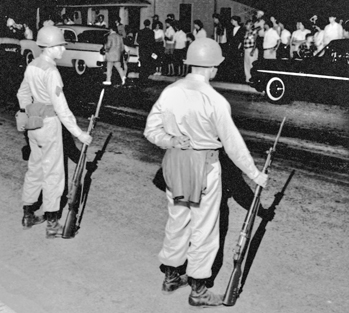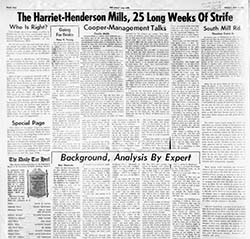1958 to 1961: A Town Divided by Mills, Jobs and Violence
The textile industry was a key component of the North Carolina since its beginnings in the 1840s. Cotton mills opened across the state and employed hundreds of thousands of workers. New towns, technology, and even forms of music came out of this industry. But most cotton mills also treated their workers poorly. Sometimes, workers took drastic action to improve their treatment. One example was the Harriet-Henderson strike of 1959.
The Harriet-Henderson strike happened at the Harriet Mills and the Henderson Mills in Henderson, North Carolina. Workers across the state were working longer hours for less money. They also had to work faster. Managers set impossible goals for employees and production. And this led to anxiety and hours of painful, stressful labor at dangerous machines. They also controlled visits to the bathroom and monitored workers when they took a break.
At the Harriet and Henderson Mills, workers responded by joining the Textile Workers Union of America. Unions help workers come together to ask for -- and at time demand -- better conditions. And sometimes they walk off the job in a strike if those conditions are not provided. They also negotiated work contracts with management. While there were many unions across the country, the plants in Henderson had one of the only textile unions in North Carolina. And this was an exception to the overall historical lack of unions in the state. In Henderson, the union had many members. And they often signed contracts with management for better pay and conditions.
In November of 1958, the union and mill management failed to come to an agreement. And so the Harriet and Handerson workers went on strike. The strike kept the mill closed for several months. Union members protested in front of the mill every day. In February of 1959, mill owners hired workers who were not part of a union. These strikebreakers drew the anger of union workers and Henderson residents who supported the union. There were shootings and bombings throughout the divided town. Union supporters blew up one of the factory boilers. Life in Henderson ground to a halt. One local banker said that merchants "are afraid to ask payment for bills lest dynamite aimed at non-strikers be aimed at them." North Carolina Governor Luther Hodges, a former textile executive, called in highway patrolmen and the National Guard to maintain order. The unrest continued for months.
The strike appeared to be over in April 1959. Management agreed to a new contract that met worker demands and allowed strikers to return to their jobs. However, the agreement was soon ignored by management, and the strike restarted. At first, Governor Hodges criticized management. He argued that the mill had "intentionally or otherwise misled all of us, including myself" when it refused to grant jobs to all returning strikers. But Hodges did little to help the union, and the workers were discouraged. The strike officially ended in June 1961. The union became powerless in Henderson. Many former strikers never worked at the mills again. The mills continued to operate until their closure in 2003.
The strike was one of many defeats for southern textile unions in the 20th century. These defeats cost unions money and membership. Unions tried to pay wages to workers who were on strike and no longer receiving a paycheck from the mill. A failed strike cost the union thousands of dollars. The Harriet-Henderson strike further weakened unions in North Carolina especially. North Carolina is now the state with the second-lowest percentage of workers in a union. Low union participation often means lower wages and fewer workplace protections for the state's workers.
The strike also had an effect on Henderson. The town was divided for many years. Local citizens tried to forget the incident had ever occurred. It has been over 60 years since the strike and over 15 years since the mill shut down. In many ways, the town has moved on. But Henderson will always be remembered for this dramatic moment in the history of workers and industry in North Carolina.
References:
North Carolina Office of Archives and History. "Harriet-Henderson Strike." North Carolina Highway Historical Markers, 2007.
Powell, William S. North Carolina Through Four Centuries. Chapel Hill: University of North Carolina Press, 1989.
Sauter, Michael B. "States with the highest percentage of labor union members in the workforce," USA Today, March 23, 2019, https://www.usatoday.com/story/money/business/2019/03/23/union-workers-s...
 History of Labor Unions in North Carolina
History of Labor Unions in North Carolina